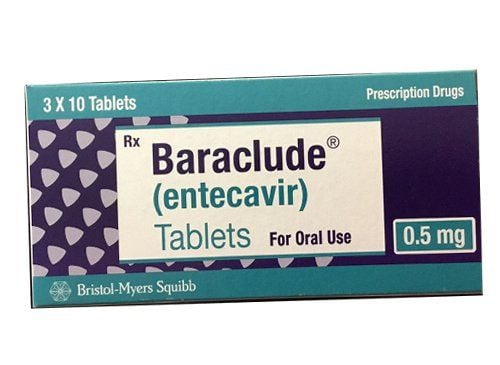This is an automatically translated article.
Tefostad 300 is used in combination with other antiretrovirals in the treatment of HlV-type l (HIV-l) infection in adults, treatment of chronic hepatitis B, against mutated HBV virus resistant to HIV. lamivudin,... The following article will help you better understand the uses of Tefostad 300.
1. What is Tefostad 300?
Tefostad 300 is a product of Stella Pharm, with the main ingredient being Tenofovir disoproxil fumarate indicated in the prevention and treatment of HIV-type 1 (HIV-1) infection in adults, treatment of chronic hepatitis B active against lamivudine-resistant mutant HBV.
Tefostad 300 tablets in teardrop shape, blue film coated
Ingredients: Tenofovir disoproxil
Content: 300-mg
2. Uses of Tefostad 300
Indications
Tefostad T300 is indicated for use in the following cases:
Tenofovir disoproxil fumarate is used in combination with other antiretroviral drugs (but should not be used alone) in the treatment of HIV-type 1 (HIV) infection -1) in adults. Tenofovir disoproxil fumarate is used in combination with other antiretroviral agents for the prevention of HIV infection after exposure (occupational or non-occupational) in individuals at risk of viral infection. Tenofovir disoproxil fumarate is also used in the treatment of chronic hepatitis B in adults. Like adefovir, tenofovir is also active against lamivudine-resistant mutant HBV. How to use - Dosage of the drug Tefostad T300
How to use:
Tefostad 300 tablets are taken orally once a day, unaffected by meals.
Dosage:
Adults
Treatment of HIV infection: 1 tablet x 1 time/day, in combination with other antiretroviral drugs. Prophylaxis of HIV infection after occupational exposure: 1 tablet x 1 time/day in combination with other antiretroviral agents (usually in combination with lamivudine or emtricitabine). Prophylaxis should begin as soon as possible after occupational exposure (preferably within hours rather than days) and continue for the next 4 weeks if tolerated. Prophylaxis of non-occupational HIV infection: 1 tablet x 1 time/day in combination with at least 2 other antiretrovirals. Prophylaxis should begin as soon as possible after non-occupational exposure (preferably within 72 hours) and exposure for 28 days. Treatment of chronic hepatitis B: The recommended dose is 1 tablet once daily for 48 weeks. Patients with renal impairment
The dose of tenofovir disoproxil fumarate should be changed by adjusting the dosing interval in patients with renal impairment based on the patient's creatinine clearance (C):
CI>50 ml/min: Dose Usually once a day. CI 30 to 49 ml/min: Administer every 48 hours. CI 10 to 29 ml/min: Administer every 72 to 96 hours. Hemodialysis patients: Administer one dose every 7 days or after an additional 12-hour portion. Because the safety and efficacy of these doses have not been evaluated in clinical studies, close monitoring of clinical response to therapy and renal function is recommended.
Patients with hepatic impairment
For patients with impaired liver function no dose adjustment is necessary.
Note: The above dosage is for reference only. The specific dose depends on the condition and the progression of the disease. To get the right dose, you need to consult your doctor or healthcare professional.
3. Side effects of Tefostad T300
The most common adverse effects (1/100 < ADR < 1/10) when using tenofovir disoproxil fumarate are mild gastrointestinal effects, especially diarrhea, vomiting and nausea, abdominal pain, bloating gas, indigestion and loss of appetite. Serum amylase levels may be elevated and pancreatitis may occur. Hypophosphatemia is also common. Phat you can also meet. Peripheral neuropathy, headache, dizziness, insomnia, depression, asthenia, sweating and muscle pain. Increased liver enzymes, increased blood triglyceride levels, increased blood glucose and decreased neutrophils. Renal failure, acute renal failure and proximal tubular effects, including FanConi syndrome. Lactic acidosis, often associated with severe hepatomegaly and fatty liver, is common with treatment with 2-nucleoside transcriptase inhibitors. Instructions on how to handle ADR: When experiencing side effects of the drug, it is necessary to stop using it and notify the doctor or go to the nearest medical facility for timely treatment.
4. Note when using Tefostad 300
Contraindications:
Patients with hypersensitivity to tenofovir disoproxil fumarate or any component of the drug. Precautions for use:
When using tenofovir, as with other reverse transcriptase inhibitors, alone or in combination, lactic acidosis, severe hepatomegaly, and steatosis (possibly fatal) have been reported. .
Proliferative adipose tissue: Redistribution or accumulation of body fat including abdominal obesity, anterior-posterior neck hypertrophy (buffalo hump), peripheral nerve damage, facial, mammary gland enlargement, Cushing's syndrome has been reported with antiretroviral agents.
Effects on bone: When tenofovir is used concurrently with lamivudine and in HIV-infected patients, there is a decrease in the mineral density of the lumbar spine, an increase in the concentration of 4 biochemical factors in bone metabolism, an increase in the concentration of bone metabolism. parathyroid hormone in serum.
Close monitoring of bone is required in HIV-infected patients with a history of pathological fractures, or at high risk of osteopenia. Although the effectiveness of calcium and vitamin D supplements has not been studied, supplementation may be beneficial for these patients.
When there are bone abnormalities, consult a doctor.
Patients with pre-existing liver dysfunction including chronic progressive hepatitis have a frequent increase in liver function abnormalities during combination antiretroviral therapy and should be monitored by other means. standard law. If there is evidence of worsening liver disease in these patients, temporary discontinuation or discontinuation of treatment should be considered.
Exacerbations of severe HBV infection have been reported in HIV-infected patients following discontinuation of tenofovir therapy. Clinical and experimental liver function should be closely monitored for at least several months after discontinuation of tenofovir in patients with concomitant HBV and HIV infection. If appropriate, treatment for HBV infection should be initiated.
The clinical activity of tenofovir disoproxil fumarate against human hepatitis B virus (HBV) has not been determined. It is not known whether treatment in patients with co-infected HIV-1 and HBV leads to the development of HBV resistance to tenofovir disoproxil fumarate and other agents.
Immune-activated syndrome:
In HIV-infected patients who are severely immunocompromised at the time of initiation of combination antiretroviral therapy (CART), asymptomatic inflammatory reactions or disease may develop. opportunistic infections and cause serious clinical problems or exacerbations of symptoms. Typically, these reactions are seen within the first few weeks or months of initiating CART.
Examples include cytomegalovirus retinitis, systemic and/or localized mycobacterium infections, and Pneumocystis carinii pneumonia.
Ability to drive and use machines
No studies have shown that the drug affects the ability to drive and use machines. However, patients should be informed of the potential for dizziness during treatment with tenofovir disoproxil fumarate.
Pregnancy
There is no clinical information on the use of tenofovir disoproxil fumarate during pregnancy.
Tenofovir disoproxil fumarate should only be used when the benefit justifies the risk to the fetus. However, because the potential risk to the developing fetus is unknown, the use of tenofovir disoproxil fumarate in women of reproductive age should be accompanied by effective contraception.
Lactation
It is not known whether tenofovir disoproxil fumarate is excreted in breast milk. It is recommended that women being treated with tenofovir disoproxil fumarate not breastfeed. As a general rule, it is recommended that women living with HIV should not breastfeed to avoid transmitting HIV to their babies.
5. Overdose, missed dose and treatment
Overdose:
If an overdose occurs, the patient should be monitored for signs of toxicity, and standard supportive measures should be used.
Tenofovir is effectively eliminated by hemodialysis with a separation factor of approximately 54%. With a single 300 mg dose, approximately 10% of a tenofovir dose was eliminated during a 4-hour hemodialysis session.
Missed dose:
If you forget to take a dose, take it as soon as possible. However, if it is almost time for your next dose, skip the missed dose and take your next dose at the scheduled time. Do not take double the prescribed dose.
6. Drug interactions
Drugs that are affected by or metabolised by hepatic mitochondrial enzymes:
The pharmacokinetic interaction of tenofovir with inhibitors or substrates of hepatic mitochondrial enzymes is unknown. Tenofovir and its prodrugs are not substrates of the CYP450 isoenzyme, and do not inhibit the CYP isoforms 3A4, 2D6, 2C9, or 2E1 but are mildly inhibited on 1A. Drugs Affected or Excreted by Renal: Tenofovir interacts with drugs that reduce renal function or compete with tenofovir for active tubular secretion (eg, acyclovir, cidofovir, ganciclovir, valacyclovir, valganciclovir), causing increased plasma concentrations of tenofovir or co-administered drugs.
HIV protease inhibitors: There is an additive or synergistic interaction between tenofovir and HIV protease inhibitors such as amprenavir, atazanavir, indinavir, nelfinavir, ritonavir, saquinavir.
Non-nucleoside reverse transcriptase inhibitors: Additive or synergistic interactions between tenofovir and non-nucleoside reverse transcriptase inhibitors such as delavirdin, efavirenz, nevirapine.
Nucleoside reverse transcriptase inhibitors: Additive or synergistic interactions between tenofovir and nucleoside reverse transcriptase inhibitors such as abacavir, didanosine, emtricitabine, lamivudine, stavudine, zalcitabine, zidovudine.
Adefovir: Tenofovir should not be co-administered with adefovir.
Didanosin: Tenofovir increases the plasma concentration of didanosine, so the combination of these two drugs is not recommended.
Oral contraceptives: The pharmacokinetics of oral contraceptives containing ethinyl estradiol and norgestimat are unknown.
Storage:
Store in sealed packaging, in a dry place. The temperature should not exceed 30°C.
Please dial HOTLINE for more information or register for an appointment HERE. Download MyVinmec app to make appointments faster and to manage your bookings easily.













